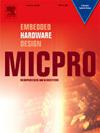Lower the RISC: Designing optical-probing-attack-resistant cores
IF 1.9
4区 计算机科学
Q3 COMPUTER SCIENCE, HARDWARE & ARCHITECTURE
引用次数: 0
Abstract
Recently, a new Side-Channel Analysis (SCA)-based attack, namely the Optical Probing (OP) attack, has been shown to bypass the implemented protection mechanisms on the chip, allowing unauthorized access to confidential information such as stored security keys or Intellectual Property (IP). Several countermeasures against the OP attack exist, which require changes in the chip’s fabrication process, i.e., chip fabrication using OP-resistant materials, resulting in increased fabrication costs. On the other hand, other countermeasures are implemented at the layout level. These countermeasures suffer from a significant drop in performance due to the utilization of custom logic cells. Additionally, available techniques against OP at the layout level require a layout design of the logic cell library from scratch which is a time-consuming process. In this work, we mitigate these limitations and propose a methodology to design high-performance OP-attack-resistant circuits. Using a two-folded methodology, we achieve an OP attack-resistant circuit. Firstly, we design a high-performance, and Low optical Leakage-Dual Rail Logic (LoL-DRL) cell library based on a standard CMOS logic cell library. Hence, no complete redesign of the layout is required. Secondly, we propose a streamlined synthesis technique to synthesize OP-attack-resistant circuits from the original circuit’s netlist. Thus, our method seamlessly integrates into the existing synthesis flow. On top of that, we analyzed the optical leakage information of several logic cells from both the standard logic cell library and our proposed LoL-DRL logic cell library against the OP attack. We used a metric called Optical Leakage Value (OLV) to report the robustness of a logic cell against the OP attack. Furthermore, as a case study, we applied our design methodology to an open-source RISC-V core to design the first OP-attack-resistant RISC-V core, named Lo-RISK. Our approach minimizes any adverse impact on performance yet incurs significant expenses in terms of both area and power consumption, which is acceptable for an OP-secure end product. On average, our proposed LoL-DRL logic cell library exhibits less information leakage through OP compared to the standard CMOS logic cell library. Our approach to designing OP-resistant circuits result in the area and a power increase while operating at the same frequency in comparison to a circuit designed using a standard CMOS logic cell library.
降低 RISC:设计抗光攻击的内核
最近,一种新的基于侧信道分析(SCA)的攻击,即光学探测(OP)攻击,被证明可以绕过芯片上已实施的保护机制,允许未经授权访问存储的安全密钥或知识产权(IP)等机密信息。目前已有几种针对 OP 攻击的对策,但需要改变芯片制造工艺,即使用抗 OP 材料制造芯片,从而导致制造成本增加。另一方面,其他对策是在布局层面实施的。由于使用定制逻辑单元,这些对策的性能会大幅下降。此外,现有的布局级反 OP 技术需要从头开始进行逻辑单元库的布局设计,这是一个耗时的过程。在这项工作中,我们减少了这些限制,并提出了一种设计高性能抗 OP 攻击电路的方法。我们采用双重方法实现了抗 OP 攻击电路。首先,我们在标准 CMOS 逻辑单元库的基础上设计了一个高性能低光漏双轨逻辑(LoL-DRL)单元库。因此,无需重新设计电路布局。其次,我们提出了一种简化的合成技术,可从原始电路的网表合成抗 OP 攻击电路。因此,我们的方法可以无缝集成到现有的综合流程中。在此基础上,我们分析了标准逻辑单元库和我们提出的 LoL-DRL 逻辑单元库中多个逻辑单元的光泄漏信息,以对抗 OP 攻击。我们使用一种名为 "光学泄漏值"(OLV)的指标来报告逻辑单元对 OP 攻击的鲁棒性。此外,作为一项案例研究,我们将我们的设计方法应用于一个开源 RISC-V 内核,设计出第一个抗 OP 攻击的 RISC-V 内核,命名为 Lo-RISK。我们的方法最大限度地减少了对性能的不利影响,但在面积和功耗方面却产生了巨大的开销,这对于 OP 安全的最终产品来说是可以接受的。与标准 CMOS 逻辑单元库相比,我们提出的 LoL-DRL 逻辑单元库平均减少了 2 倍的 OP 信息泄漏。与使用标准 CMOS 逻辑单元库设计的电路相比,我们的抗 OP 电路设计方法在相同频率下工作时,面积增加了 2 倍,功耗增加了 1.36 倍。
本文章由计算机程序翻译,如有差异,请以英文原文为准。
求助全文
约1分钟内获得全文
求助全文
来源期刊

Microprocessors and Microsystems
工程技术-工程:电子与电气
CiteScore
6.90
自引率
3.80%
发文量
204
审稿时长
172 days
期刊介绍:
Microprocessors and Microsystems: Embedded Hardware Design (MICPRO) is a journal covering all design and architectural aspects related to embedded systems hardware. This includes different embedded system hardware platforms ranging from custom hardware via reconfigurable systems and application specific processors to general purpose embedded processors. Special emphasis is put on novel complex embedded architectures, such as systems on chip (SoC), systems on a programmable/reconfigurable chip (SoPC) and multi-processor systems on a chip (MPSoC), as well as, their memory and communication methods and structures, such as network-on-chip (NoC).
Design automation of such systems including methodologies, techniques, flows and tools for their design, as well as, novel designs of hardware components fall within the scope of this journal. Novel cyber-physical applications that use embedded systems are also central in this journal. While software is not in the main focus of this journal, methods of hardware/software co-design, as well as, application restructuring and mapping to embedded hardware platforms, that consider interplay between software and hardware components with emphasis on hardware, are also in the journal scope.
 求助内容:
求助内容: 应助结果提醒方式:
应助结果提醒方式:


